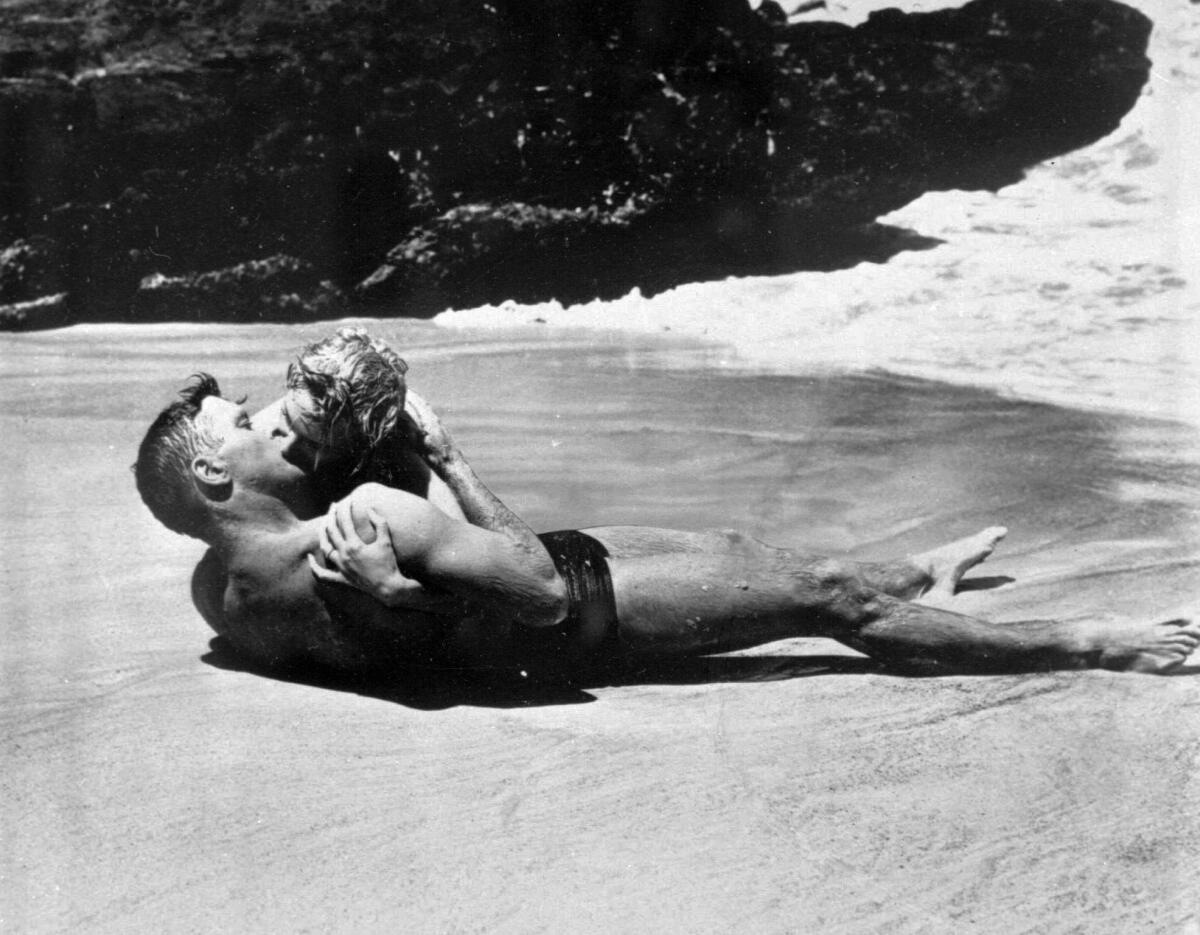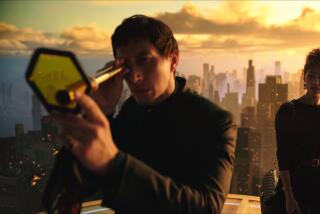From the Archives: ‘Here to Eternity’ blasts viewers with atomic power

- Share via
“From Here to Eternity” comes to the screen as a supreme mob-inciter. It will wave furiously and long to cause an enormous stir — never too patriotically.
This film, showing at RKO Hill Street and Pantages Hollywood theaters, is sensationalism gone rampant with sex, cruelty, and all the ruddy elements which make for what is known as rough, rugged, brutal appeal. It has to do with soldiering, but it dallies preeminently with sex, and is only in minor degree concerned with war.
Pre-Pearl Harbor
Taken from the book by James Jones, the picture assumes to delineate peacetime troop conditions, especially the conditions that existed in Pearl Harbor before Dec. 7, 1941. To say that it is rich in compassion would be false. There is far more of bitterness about the story as it is told.
Take or leave it, “From Here to Eternity” goes all out in making the military situation look its worst, and could probably be used by alien interests for subversive purposes if they happened to want to make capital of this production. Certainly it wouldn’t spur parents to encourage youthful enlistments, if they thought such conditions existed in the services today.
These things may stand against “From Here to Eternity” in the minds of those who view what are termed precarious issues of the present. However, that doesn’t diminish the great technical coup that has been scored in this feature, particularly through the casting, so often referred to as miscasting, of such players as Deborah Kerr, Frank Sinatra, Donna Reed and one or two others, the direction by Fred Zinnemann, and the general treatment of a story that was regarded for a long time as just too hot to handle.
Original heat there
The Jones book is rough in words and general outspokenness, and while its potentially offensive conversation “embellishments” have not found their way into the picture, much of the original heat has. Wherefore “From Here to Eternity” is a whale of a provocative screen smash, which will doubtless pack crowds into the theaters for many days.
Many people will probably claim honors for the box-office triumph that it already is achieving elsewhere, and probably due to duplicate here. Columbia Studio presents the film and it was produced by Buddy Adler, while Daniel Taradash devised the adroit screenplay. It was adroit because it had to avoid much that would have proved utterly censorable, and yet has kept what is essential intact.
Burt Lancaster and Montgomery Clift head the cast, though theirs are not the most unusual, even though important, assignments. Miss Kerr, Sinatra and Miss Reed break completely with their cinema past.
Miss Kerr portrays Karen, the wife of Capt. Holmes, who leads her own love life where she can best find it, while her officer husband industriously adventures elsewhere. She and Lancaster, the top sergeant, join forces to become a red-hot romantic team, their scene on the beach being one to cause the screen to sizzle, and almost going overboard.
Sinatra different
Sinatra has big different duty as Maggio, with an unrestrained sort of temperament which leads him readily to the domain of light o’ loves in Hawaii, even as he is forever finding the bottle handy to seek gaiety and release. His is a fate to be sealed horribly and tragically by the stockade boss, Fatso Judson. His scenes are bound to hit hard because of their poignance.
In Maggio’s retreat dedicated to pleasure, Clift as Prewitt is destined to find Miss Reed as one of the Calypsos, though she is never a brassy siren. She provides him with shelter when he is most in need of such aid after his terrible knife battle with Judson.
All the performances reach quick, surpassing heights required when the scenes happen to hit a crescendo. Lancaster is highly consistent in what he does. Clift evidences the appeal that has made him popular along more or less straight-out strenuous lines.
Miss Kerr, Miss Reed and Sinatra all catch new moods, with Sinatra coming off the best, and the two women about equal in accomplishment, Miss Kerr having the more significant duty.
Philip Ober is fine as Capt. Holmes. Ernest Borgnine is terrific as Fatso, while Mickey Shaughnessy as Sgt. Leva, Harry Bellaver as Mazzioli, Jack Warden, John Dennis, Barbara Morrison and others too many to mention are highly effective in the cast. The picture concentrates on story, bypassing new technical advances, and is excellently photographed by Burnett Guffey. Though most of the picture deals with events before the Pearl Harbor attack, that disaster is also amazingly depicted.
Abrupt tragedies
This picture is filled with sudden tragedies, often ghastly and the kind that can only be linked with war or the threat of it.
To be sure ,“From Here to Eternity” ends when war begins, but there is a big doom ever lurking over what happens. Some people will say that such things were bound to be in the peacetime military of the islands. But this is rather to be judged by historians than a reviewer who must perforce appraise this remarkable picture all too quickly and cursorily.
I can’t cheer “From Here to Eternity” as a subject rich in inspirational values like that unique achievement “The Robe,” but I can admire it simultaneously for its surpassing vigor, vitality and power. It is an assailing screen event.
Along with this feature is showing the United Productions of America short subject, Edgar Allan Poe’s “The Tell-Tale Heart,” narrated by James Mason. This film is one of the oddest and eeriest of the company’s productions.
More to Read
Only good movies
Get the Indie Focus newsletter, Mark Olsen's weekly guide to the world of cinema.
You may occasionally receive promotional content from the Los Angeles Times.










